Maruha’s heavy duty radiator has the same shape as the genuine one. For the core we use the aluminum core we’ve already mentioned before. Keeping in mind light weight, heat dissipation and cost we managed to develop a high-quality product.
We improved the tube pitch and the fin pitch.
Core 26mm (genuine radiator – 16mm)
Fin pitch modification
Tube pitch modification
Modification of the number of the fins
Dry weight almost the same as in the case of the genuine one
Inner capacity modification
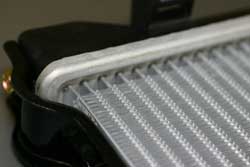
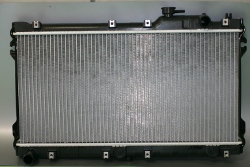
There are 3 types of Maruha’s radiator caps: 0.9Kgcm2 1.1Kgcm2 1.3Kgcm2.
The standard for NA is 0.9Kgcm2 / the standard for NB is 1.1Kgcm2.
You can purchase the cap as a single item.
Radiator (genuine hose)
Radiator (MARUHA silicone hose)
Radiator (SFS hose)
At Maruha we use a special testing machine for verifying the radiator’s cooling capability.
In both cases (Maruha radiator – Mazda genuine radiator) we use new products for the comparison.
The water’s heat release is being converted accordingly to the temperature difference at the water and air’s entrance and exit.
Too much heat release can lead to overcooling and not enough heat release leads to overheating.
The pressure difference between the radiator water’s entrance and exit.
If the radiator’s inner tube’s area is small the flow velocity becomes higher and the pressure loss becomes bigger.
If the pressure loss is too big the power necessary for the water circulating (the water pump’s output) becomes bigger and it leads to overheating.
If the air pressure loss is too small, the water’s thermal conductivity lessens and there is not enough heat exchange which also might lead to overheating.
As the heat release, the air pressure loss and the water pressure loss are all related, it is very important to maintain their balance.
If this balance is good the radiator’s efficiency becomes better.
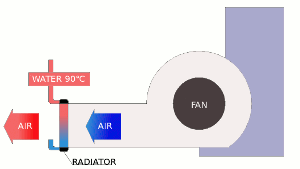
The testing machine is a special machine designed for radiators.
Matching the real driving conditions it changes the wind velocity and makes it possible to test on low speed and high speed too.
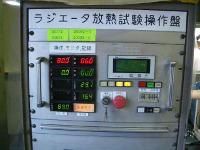
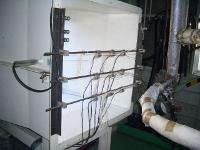
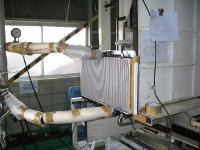
The water’s temperature that is being sent to the radiator is set to 90°C.
The temperature is the same as that under normal driving conditions when the thermostat opens and the coolant starts to circulate.
We are constantly pouring 90°C water into the radiator and we control the process by a big boiler.
Using the difference with the returning water’s temperature we calculate the heat radiation calorie.
If the difference in pressure is big we can say that the radiator doesn’t let the water pass through smoothly.
The water pump’s load becomes big and it leads to the engine’s output’s declining.
The radiator is fixed to the flow duct and so the flow passes through the radiator completely.
Depending on the 3-layer radiator, core fin pitch etc. the air flow can become bad and the radiator’s efficiency lessens too.
The passing air’s temperature is being checked at each area of the divided radiator and we can confirm if the cooling function works properly.
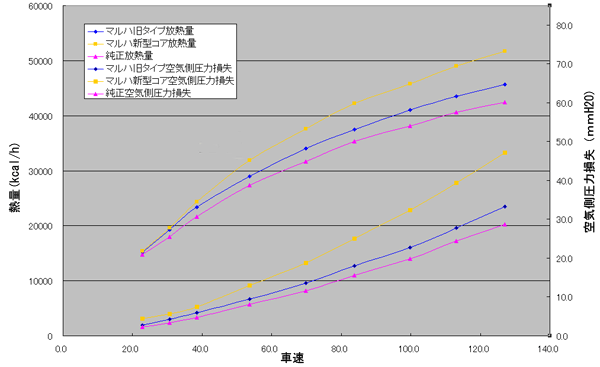
The heat release compared to the genuine product is better and the higher the car’s speed the more the heat release.
Compared to the genuine radiator the pressure loss is 13~23% bigger. Up to 40km/h wind velocity the pressure loss is 21-23% and after that it becomes 13-17%. We can assume that this difference is caused by the change in the core’s thickness from 16mm to 26mm.
The fact that the pressure loss is big means that the air cannot get out easily. Even in the case of low rpm there is enough heat release which means that overheating doesn’t happen.
In the case of the genuine radiator the water pressure loss is bigger.
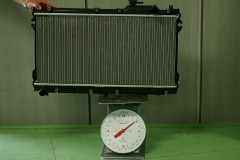
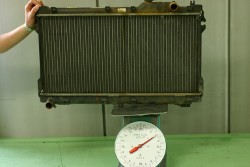
Maruha’s radiator’s core is 26mm thick while the genuine one is 16mm which means that because of the aluminum core it is a few hundred grams heavier.
The copper radiator is two times heavier than the genuine radiator.
The aluminum 3-layers radiator is also heavy.
However, users like radiators when they are light and thick. That’s why we recommend our radiator for Miata/MX-5 users.
[home]